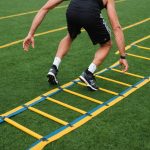Crafting a well-structured weekly training plan for high jumpers can significantly enhance performance. This guide offers tailored strategies and techniques to optimize workouts, combining strength training, flexibility exercises, and jump drills. Understanding the unique demands of high jump, the plan addresses both physical conditioning and mental preparation. Whether you're a beginner or an experienced athlete, this framework aims to elevate your training intensity and efficiency—empowering you to reach new heights in your high jump journey.
Understanding the High Jump Event
Exploring the essentials of high jump.
In parallel : Unlock the fun: top gel blaster pistols for every gamer
Overview of Rules and Regulations
The high jump event is a captivating display of athleticism, governed by specific rules. Competitors must leap over a horizontal bar without dislodging it. Each athlete is allowed three attempts at each height. The bar is raised progressively, and the jumper with the highest successful clearance wins.
Key Techniques for Successful High Jumping
Mastering the technique essentials is crucial for success. The approach run is critical, involving a curved path to generate optimal speed and angle. The takeoff requires precise timing and explosive power, as the jumper propels upward. During flight, the Fosbury Flop technique is often employed, where the athlete arches their back and clears the bar headfirst. Landing safely on the mat completes the jump.
This might interest you : Top pistol gel blasters for realistic, safe indoor and outdoor play
Importance of Mental Preparation
Mental preparation is as vital as physical prowess. High jumpers must cultivate focus and confidence to excel. Visualizing successful jumps and maintaining a positive mindset can significantly enhance performance.
- High jump fundamentals:
- Approach run
- Takeoff
- Flight
- Landing
Understanding these elements and their interplay is essential for aspiring high jumpers. By honing both physical and mental skills, athletes can reach new heights in this thrilling sport.
Assessing Athlete's Current Level
Evaluating skills to enhance performance.
Methods for Evaluating Jumping Ability and Technique
Effective athlete assessment is vital for understanding a jumper's current capabilities. Coaches employ various methods, such as video analysis and biomechanical assessments, to evaluate jumping ability. These techniques help identify strengths and areas for improvement, ensuring tailored training.
Importance of Setting Realistic and Measurable Goals
Setting realistic and measurable goals is crucial for progress. By using performance metrics, athletes can track improvements and adjust training accordingly. Goals should be specific, achievable, and time-bound, fostering motivation and focus.
- Performance metrics include:
- Jump height
- Approach speed
- Takeoff angle
Factors Affecting Performance
Several factors influence a high jumper's performance. Age, fitness level, and experience play significant roles in determining an athlete's potential. Younger athletes may have more room for improvement, while experienced jumpers might focus on refining technique. Fitness level impacts both power and endurance, essential for successful jumps.
A quote from a seasoned coach underscores the importance of comprehensive skill evaluation: "Understanding an athlete's baseline is the first step towards unlocking their full potential."
By assessing jumping ability and setting achievable goals, athletes can optimize their performance and reach new heights.
Designing the Weekly Training Structure
Crafting a balanced training schedule for high jumpers.
Components of an Effective Weekly Training Plan
An effective weekly training plan is essential for high jumpers aiming to enhance their skills. It should incorporate a mix of strength, technique, and endurance training modalities. Balancing these components ensures comprehensive development and minimizes injury risk.
Balancing Different Training Modalities
To optimize performance, athletes should allocate specific days to each training modality. For instance, strength training might focus on building core and leg muscles, while technique sessions hone the approach and takeoff skills. Endurance workouts improve overall stamina, crucial for maintaining performance throughout competitions.
Sample Weekly Training Structure:
- Monday: Strength Training (Legs and Core)
- Tuesday: Technique Drills (Approach and Takeoff)
- Wednesday: Rest or Light Recovery
- Thursday: Endurance Training (Running and Plyometrics)
- Friday: Technique Refinement (Fosbury Flop Practice)
- Saturday: Combined Session (Strength + Technique)
- Sunday: Rest and Mental Preparation
Sample Weekly Training Structure for Various Skill Levels
Tailoring the weekly plan to an athlete's skill level is crucial. Beginners might focus more on technique, while advanced jumpers emphasize strength and endurance. A well-rounded training methodology ensures that high jumpers progress effectively, enhancing their overall performance. As one coach notes, "A structured plan is the backbone of athletic success."
Strength and Conditioning Exercises
Essential exercises for high jump excellence.
Key Strength Exercises for High Jumpers
Strength training is vital for high jumpers, focusing primarily on legs and core muscles. Exercises such as squats, lunges, and deadlifts enhance muscle development, providing the power needed for explosive takeoffs. Core exercises, including planks and Russian twists, improve stability and control during jumps.
Recommended Conditioning Routines
Incorporating conditioning exercises into training routines boosts overall athleticism. High-intensity interval training (HIIT) and circuit training are effective methods. These routines enhance cardiovascular endurance and muscular endurance, crucial for maintaining performance throughout competitions.
Here's a sample conditioning routine:
- Warm-up: Dynamic stretches
- Main set:
- 3 rounds of:
- 20 squats
- 15 push-ups
- 30-second plank
- Cool down: Static stretches
Importance of Flexibility and Mobility Work
Flexibility and mobility are often overlooked but are essential components of a high jumper's training. Regular stretching and mobility exercises, such as yoga or dynamic stretches, prevent injuries and improve range of motion. This flexibility allows athletes to execute the Fosbury Flop with greater efficiency.
A seasoned trainer emphasizes, "Flexibility is the bridge between strength and technique, ensuring each jump is fluid and powerful." Integrating flexibility into strength training and conditioning exercises ensures a balanced, effective training regimen.
Technique Drills and Practice
Enhancing skills with precision and dedication.
Specific Drills for Jump Technique and Takeoff
To excel in the high jump, athletes must engage in specific drills that target jump technique and takeoff efficiency. One effective drill is the approach run simulation, where athletes practice their curved approach to perfect speed and angle. Another essential drill is the takeoff box drill, which focuses on explosive power and timing by jumping off a raised platform onto a mat.
Importance of Repetition and Feedback
Repetition and feedback are crucial for skill enhancement. Regular practice of technique drills helps embed muscle memory, allowing athletes to perform consistently. Feedback from coaches, using real-time observations or recorded sessions, provides valuable insights for improvement. As a renowned coach states, "Repetition is the mother of skill, and feedback is its guiding light."
Incorporating Video Analysis for Technique Refinement
Video analysis is a powerful tool for refining technique. By reviewing footage, athletes can identify subtle errors in their jump execution. This process allows for precise adjustments, leading to more efficient and effective jumps.
- Benefits of video analysis:
- Visual feedback on form
- Identification of technical flaws
- Tracking progress over time
Incorporating these elements into practice routines ensures comprehensive skill enhancement, paving the way for high jump success.
Recovery and Injury Prevention Strategies
Essential approaches for maintaining athlete health.
Effective Recovery Methods
Proper recovery techniques are vital for maintaining athlete health and preventing injuries. Rest is a fundamental component, allowing the body to repair and strengthen. Adequate nutrition fuels recovery, while hydration aids in muscle function and reduces fatigue. A balanced combination of these elements enhances overall recovery efficiency.
Common Injuries and Prevention Strategies
High jumpers often face specific injuries such as ankle sprains, knee strains, and lower back pain. Implementing injury prevention strategies is crucial. Regular strength and flexibility exercises can fortify muscles and joints, reducing injury risk. Additionally, employing proper technique during jumps minimizes strain on the body.
- Common Injuries:
- Ankle sprains
- Knee strains
- Lower back pain
Role of Cross-Training
Cross-training plays a pivotal role in maintaining fitness while recovering from injuries. Activities like swimming or cycling provide cardiovascular benefits without stressing the joints. This approach allows athletes to stay active and maintain endurance, facilitating a smoother transition back to high jump training. As one expert notes, "Cross-training keeps the body conditioned and ready for peak performance."
Incorporating these recovery techniques and injury prevention methods into an athlete's routine ensures a holistic approach to health and performance.
Performance Tracking and Analysis
Tools and methods for tracking training progress and performance.
Tracking Progress with Technology
Performance tracking is essential for high jumpers seeking to optimize their training. Utilizing tools such as wearable technology and mobile apps can provide real-time data on jump height, speed, and takeoff angle. These metrics allow athletes to monitor their progress and adjust their training regimen accordingly.
Analyzing Data for Training Adjustments
Analyzing collected data is crucial for making informed training adjustments. Coaches and athletes can identify patterns and areas for improvement by reviewing performance metrics. This data-driven approach ensures that training remains effective and focused on progress. A renowned coach emphasizes, "Data analysis is the key to unlocking an athlete's potential, guiding every step of their journey."
Incorporating Athlete Feedback
Incorporating athlete feedback into training plans is vital for personalized performance tracking. Regular check-ins and discussions allow athletes to express their experiences and challenges, providing valuable insights for coaches. This feedback loop ensures that training remains tailored to the athlete's needs, promoting continuous progress.
- Key Elements of Performance Tracking:
- Real-time data collection
- Comprehensive data analysis
- Athlete-coach feedback loop
By integrating these methods, athletes can achieve a holistic understanding of their performance, paving the way for sustained improvement and success in high jump events.
Enhancing Mental Skills for Performance
Developing focus and resilience for athletic success.
Techniques for Improving Concentration and Reducing Performance Anxiety
Mental training is crucial for athletes seeking to improve their focus and manage performance anxiety. Techniques such as mindfulness meditation help athletes concentrate on the present, reducing distractions. Breathing exercises can also alleviate anxiety by calming the nervous system. These practices ensure athletes maintain optimal mental states during competitions.
Visualization and Goal-Setting Exercises for Athletes
Visualization is a powerful psychological strategy that enables athletes to mentally rehearse successful performances. By vividly imagining each phase of their jump, athletes strengthen their mental resilience and confidence. Additionally, setting clear, achievable goals fosters motivation and provides a roadmap for progress. Regularly revisiting these goals helps maintain focus and drive.
- Key Visualization Techniques:
- Imagining successful jumps
- Visualizing the approach and takeoff
- Practicing mental rehearsal daily
Role of Mental Resilience in Competitive Performance
Mental resilience is the backbone of an athlete's ability to thrive under pressure. Developing this resilience involves embracing challenges and learning from setbacks. Encouraging a growth mindset helps athletes view failures as opportunities for improvement. As a seasoned sports psychologist notes, "Mental resilience transforms pressure into performance, empowering athletes to excel."
By integrating these focus techniques and psychological strategies, athletes can enhance their mental skills, leading to improved performance and success in high jump events.











